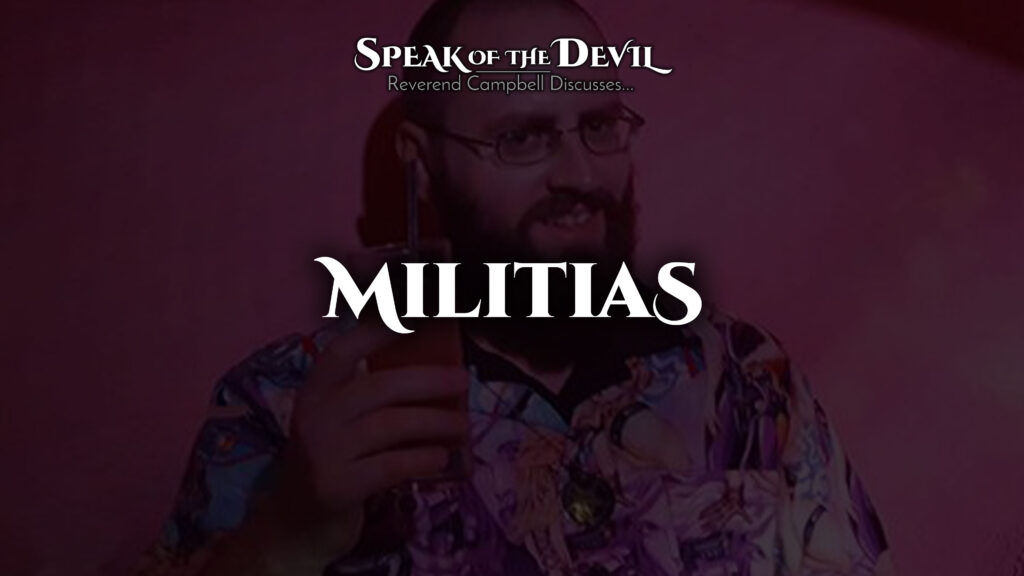Speak of the Devil – Reverend Campbell discusses militias with Warlock Jeff Bowling. We will cover their beginnings in America, what has spurred their creation over the years, and what they stand for now. Reverend Campbell dismissed militias in his last 9sense episode and Warlock Bowling thought they deserved a bit more of a discussion. He will bring his personal experience with militias to the table for clarity. Join live tonight and share your thoughts with the guest, host and audience.
Discussion
- Definitions
- a military force that is raised from the civil population to supplement a regular army in an emergency.
- a military force that engages in rebel or terrorist activities in opposition to a regular army.
- a private group of armed individuals that operates as a paramilitary force and is typically motivated by a political or religious ideology
- Why the hell is Jeff on here?!
- (I’ll give a synopsis of my personal experiences and background so people know where I am coming from.)
- Militia Act of 1903
- https://en.wikipedia.org/wiki/Militia_Act_of_1903
- also known as the Efficiency in Militia Act of 1903 or the Dick Act, was legislation enacted by the United States Congress to create an early National Guard and which codified the circumstances under which the Guard could be federalized.
- 19th century, the militia in each U.S. state and territory operated under the Militia Acts of 1792, which was extended by the Militia Act of 1795. The acts left the question of state versus federal control of the militia unresolved
- The federal government could not consistently rely on the militias for national defense.
- For example, during the War of 1812, members of the New York militia refused to take part in operations against the British in Canada
- The 1903 act repealed the Militia Acts of 1795 and designated the militia (per Title 10 of the U.S. Code, Section 311) as two classes: the Unorganized Militia, which included all able-bodied men between ages 17 and 45, and the Organized Militia, comprising state militia (National Guard) units receiving federal support.
- Militia organizations in the United States
- https://en.wikipedia.org/wiki/Militia_organizations_in_the_United_States
- These groups may refer to themselves as militia, unorganized militia, and constitutional militia.
- The catalysts came with the FBI’s 1992 shootout with Randy Weaver at Ruby Ridge, and the 1993 Waco siege involving David Koresh and the Branch Davidians at Mt. Carmel in Waco, Texas.
- Critic Mark Pitcavage described the militia movement of the 1990s:
- The militia movement is a right-wing movement that arose following controversial standoffs in the 1990s. It inherited paramilitary traditions of earlier groups, especially the conspiratorial, anti-government Posse Comitatus. The militia movement claims that militia groups are sanctioned by law but uncontrolled by government; in fact, they are designed to oppose a tyrannical government. The movement’s ideology has led some adherents to commit criminal acts, including stockpiling illegal weapons and explosives and plotting to destroy buildings or assassinate public officials, as well as lesser confrontations.
- A 1999 US Department of Justice analysis of the potential militia threat at the millennium conceded that the vast majority of militias were reactive (not proactive) and posed no threat.
- By 2001, the militia movement seemed to be in decline, having peaked in 1996 with 858 groups.
- With the post-2007 global financial crisis and the election of Barack Obama to the United States presidency in 2008, militia activity experienced a resurgence.
- Militia groups have recently been involved in several high-profile standoffs, including the Bundy Standoff in 2014 and the Occupation of the Malheur National Wildlife Refuge in 2016.
- Legal Legitimacy
- Most militia organizations envisage themselves as legally legitimate organizations authorized under constitutional and statute law, with reference to state and federal law of an “unorganized militia”.
- Title 32 of the United States Code outlines the role of the United States National Guard in the United States Code.
- Others subscribe to the “insurrection theory” which describes the right of the body politic to rebel against the established government in the face of tyranny.
- (In the 1951 case Dennis v. United States, the U.S. Supreme Court rejected the insurrection theory, stating that as long as the government provides for free elections and trials by jury, “political self-defense” cannot be undertaken.)
- Most militia organizations envisage themselves as legally legitimate organizations authorized under constitutional and statute law, with reference to state and federal law of an “unorganized militia”.
- Anti-Government Views
- many high profile organizations espousing anti-tax, anti-immigration, survivalist, sovereign citizen, libertarian, land rights and southern restoration views
- they generally share a common belief in the imminent or actual rise of a tyrannical government in the United States which, they believe, must be confronted through armed force.
- Active Militia Groups
- The Southern Poverty Law Center identified 334 militia groups at a peak in 2011. It identified 276 in 2015, up from 202 in 2014.
- Relationship between militias and street gangs/motorcycle clubs/etc.
- Radical militia members serving in the Armed Forces.
- Five myths about militias
- https://www.washingtonpost.com/outlook/five-myths/five-myths-about-militias/2020/09/04/9d7c25e0-ee23-11ea-99a1-71343d03bc29_story.html
- Militias are organized paramilitary groups that typically believe they are the last line of defense against a tyrannical federal government.
- Almost all belong to the “patriot movement,” a broad coalition of organizations that share a general resentment of the U.S. government.
- Myth No. 1 Militia members are especially prone to violence.
- A 2015 Southern Poverty Law Center study of domestic terrorism concluded that “lone wolves” or “leaderless resistance” groups were responsible for most of the violence; the vast majority of attacks were the work of one or two people, such as the lone gunman who killed 23 people in El Paso last year.
- Myth No. 2 Right-wing militants love President Trump.
- “Patriot” purists find it hard to reconcile decades of anti-government ideology with their new reality. Some believe that anyone in charge of the federal government is, by definition, the enemy, and that includes Trump.
- Myth No. 3 Militias’ anti-government views are wildly extreme.
- In 1964, 77 percent of Americans said they could trust the government in Washington to do what is right most of the time. Today, only 17 percent of citizens say the same. These days, anti-Washington sentiment is nothing if not mainstream, far more popular than its opposite.
- Myth No. 4 The ‘patriot’ movement has a consistent ideology.
- “Patriots” are motivated by a varied and sometimes conflicting array of issues. Some focus on gun rights or immigration; others get riled up about privacy, taxes or government overreach. They disagree often and are united only by their vow to protect the citizenry against a tyrannical federal government.
- Myth No. 5 Racism drives the ‘patriot movement.’
- while there are plenty of virulent racists among the “patriots,” racism is not usually part of their publicly stated ideology.
- Something I want to add in this section (not from the article) is the myth that all militias are right-wing, white, or see themselves as patriotic. There are some extremely violent ones that want to overthrow the government and completely erase the Constitution. Specifically, there is a Native American militia movement in the Southwest whose name escapes me, I will track down the info before the show.
- The Problem With Militias and the Constitution
- https://www.usnews.com/news/national-news/articles/2020-09-22/the-problem-with-militias-and-the-constitution
- THE U.S. HAS FOR decades been locked in a reckoning over the breadth of the language in the Second Amendment protecting the right to keep and bear arms. But in recent months, national attention has instead shifted to the lesser-considered subject of its first clause: “A well regulated Militia.”
- Militia groups have for years argued that their actions are constitutionally protected. But legal analysts say the Constitution does not protect private military groups that are unconnected to or outside the authority of the government. In fact, all 50 states prohibit and restrict private militia groups and militia activity with several different kinds of laws as well as provisions included in most state constitutions.
- “What we’re seeing in the kinds of militias that we see today, these sort of self-appointed militias that have no relationship with the state government whatsoever, no authority to speak for the state or for the people of the state, these are not the kinds of militias that are referenced by the Second Amendment,” says Adam Winkler, a professor of law at the University of California at Los Angeles who specializes in constitutional law and gun policy.
- Both the presence and actions of militia groups at recent racial justice protests – often under the guise of defending or protecting communities, or when they purport to function as law enforcement – violate state laws, says Mary McCord, a former Justice Department lawyer and assistant U.S. attorney who now serves as the legal director at Georgetown University’s Institute for Constitutional Advocacy and Protection.
- Yet the groups go largely unchecked because law enforcement often does not enforce anti-militia laws due to a number of overlapping reasons, most based in ignorance or misunderstanding, analysts say. Law enforcement is sometimes simply unaware of state statutes that define and prohibit private militias and paramilitary activity.
- “I think the NRA and other Second Amendment absolutists have been remarkably successful over the last several decades at sort of just convincing people that the Second Amendment protects private militia activity, especially in open carry states,” McCord says, referring to statutes that allow residents to openly carry firearms in public and in some cases permit the display of long guns like semi-automatic rifles.
- The line between a citizen legally carrying a weapon in public and what constitutes illegal paramilitary action, therefore, often goes unrecognized by law enforcement.
- In 2008, the Supreme Court ruled in a major gun rights case, District of Columbia vs. Heller, that citizens had a right to own a firearm for purposes other than being in a militia, namely for self-defense. The ruling affirmed the right of states to restrict militia-like activity.
- “There’s lots of things that are still gray areas when it comes to protecting Second Amendment activity, like certain types of firearms and things like that. But one thing that has been pretty clear that the Second Amendment does not protect is private paramilitary organizations,” McCord says.
- Mark Pitcavage, senior research fellow at the Anti-Defamation League’s Center on Extremism, says armed opposition groups showing up at recent protests largely fall into two camps: organized militias that are a part of the broad right-wing anti-government militia movement and informal groups created in direct response to the demonstrations and what community members see as a threat of violence and destruction from protesters.
- Ignorant Irony
- They are formed to stand up to a government if it alters any rights the same government put into place.
- They abuse advantage of made up rights
- They dont give a fuck about the government at all
- Why do they care about the rights the government offers in the first place?
- They are formed to stand up to a government if it alters any rights the same government put into place.

